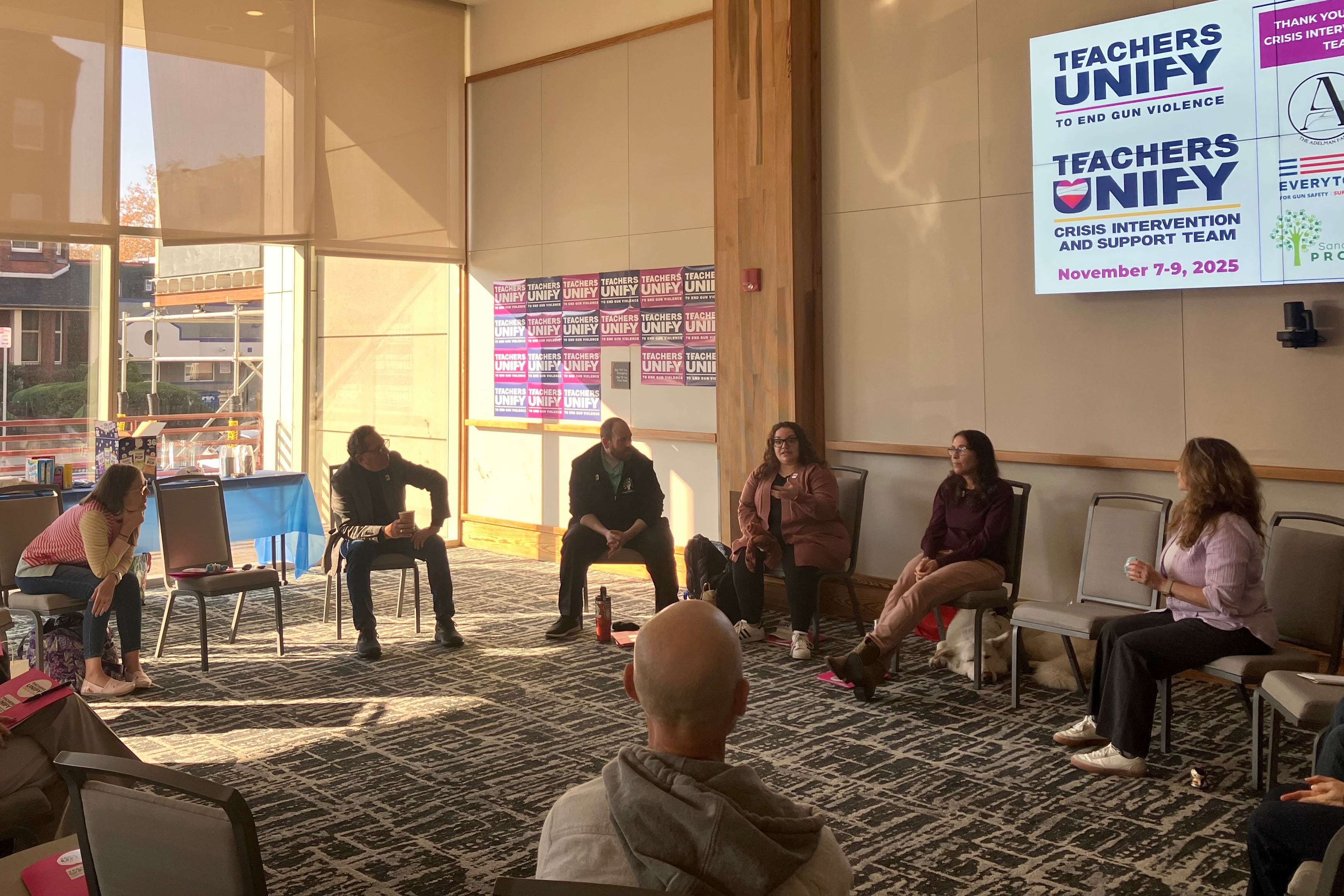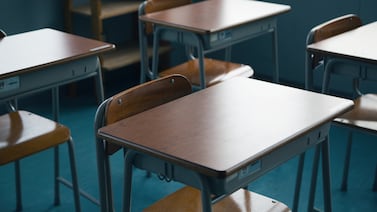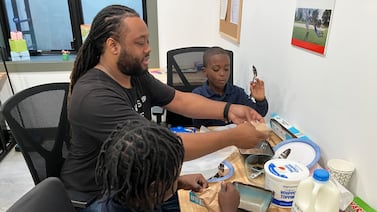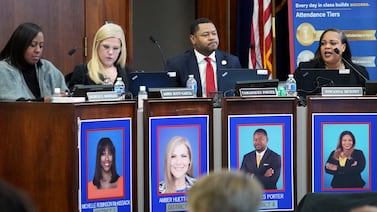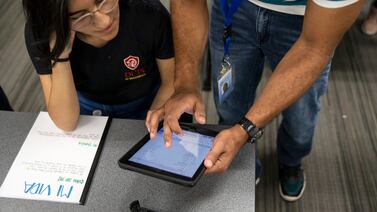Sign up for Chalkbeat Philadelphia’s free newsletter to keep up with news on the city’s public school system.
Gathered in a circle in a Philadelphia hotel conference room, 11 teachers brought out a “grounding” item — something that calms them when they feel frightened or sad.
Robin Walker brought a hand-sewn tissue pouch that another Sandy Hook Elementary School teacher made for her and their colleagues after they all survived a mass shooting there in 2012.
Amy Taylor, also a former Sandy Hook teacher, brought a rock a student had painted for her.
Ivy Schamis, who taught in a Marjory Stoneman Douglas High School classroom that was ambushed by a gunman in 2018, brought a picture of the desk in the school office where she works now. It’s protected by bulletproof glass and by her service dog, Waffles.
These are three of the nine teachers who’ve survived school shootings and are now using those experiences to support other educators. A national crisis intervention team they launched this week plans to visit campuses after mass shootings and provide one-on-one phone and email support to teachers in need.
“They don’t have to be alone with those thoughts or those fears in the aftermath of gun violence,” said Kiki Leyba, who ushered his students to safety during the 1999 Columbine High School shooting, at the team’s training on Saturday. “There are others out there who they can connect with.”
The crisis team is a project of a larger gun violence advocacy organization called Teachers Unify to End Gun Violence.
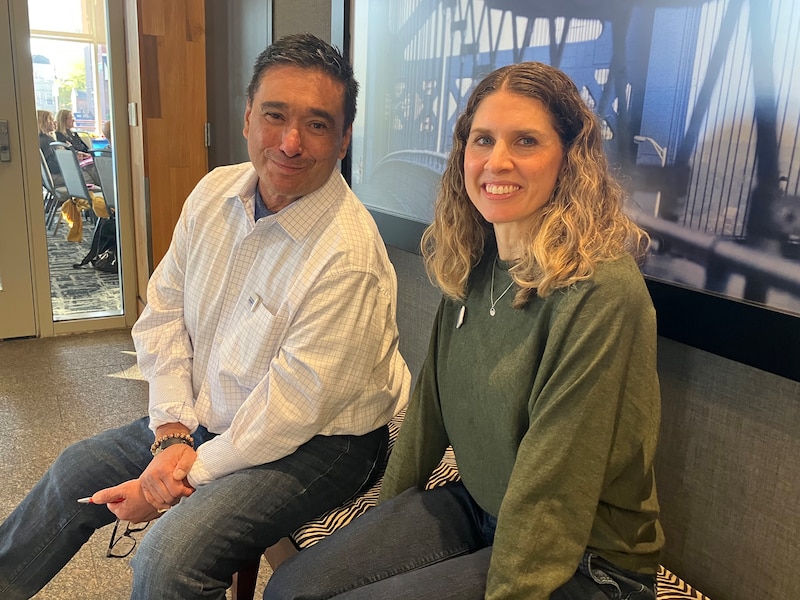
School shootings often physically injure dozens, and leave many more grappling with the events of that day. Yet the needs of educators can go overlooked by school administrations, members of the group said, and teachers often don’t know where to seek help.
Close to 400,000 students have been exposed to gun violence during school hours, according to a data analysis from The Washington Post. There is no similar count for teachers who have witnessed or been injured by a school shooting.
Leyba said he went right back to the classroom after the tragedy.
“I was not equipped to deal with the trauma,” he said. “I was just really blindsided.”
But after years of working on his own healing and speaking with fellow survivors, he feels he is ready to support others.
The inaugural cohort of teachers has been meeting with a trauma-focused psychologist and another clinician since June to learn how to offer peer support, and handle their own feelings and responses that may arise while helping others. They also received training on a five-step approach to group facilitation around difficult topics.
Educators who call the crisis line can sign up for conversations with members of the new intervention team as well as sessions with mental health professionals.
Teachers’ needs often fall by the wayside after these incidents, said Abbey Clements, cofounder of Teachers Unify to End Gun Violence and a Sandy Hook survivor.
“Often teachers don’t feel like they have what they need,” she said. “Not enough days given for grieving, not enough support to come in and help you in the classroom … You can’t concentrate. You’re not sleeping, you’re not eating. So all these things are very common.”
Following a shooting, administrators are primarily focused on student well-being, the logistics of how to get kids back to class, and incoming lawsuits from victims’ families, said Jaclyn Schildkraut, who studies mass shootings at the Rockefeller Institute of Government’s Regional Gun Violence Research Consortium at the State University of New York.
“With all of the balls that are being juggled in the aftermath, supporting teachers might be one of the lowest things on that priority list,” she said.
Peer support can help fill that gap.
“It’s the people that you don’t have to explain ‘this is why I feel the way I do’ … they just get it,” she said. “And so sometimes you can just sit there with these folks and not have to say a word, and still feel more supported than going to therapy.”

Schildkraut isn’t aware of any other existing support networks specifically for teachers after school shootings, though there is one in place for principals.
Members of the crisis team hope to work with school administrators to help them better support teachers after these kinds of tragedies. They also hope to train more teachers in the future, pending funding. The group says they’re open to helping teachers at schools where neighborhood gun violence is common, as well as those who experience shootings inside the building.
Clements said teachers especially need help with how to answer questions from students who’ve lost their classmates.
“What do you say when they say the things that they say?” she said. “Why did this happen? … Why is there a desk removed? Why aren’t we stopping at somebody’s bus stop on a bus route?”
Amy Taylor, who protected her second grade class during the Sandy Hook shooting, said going back to teach was a difficult decision.
“It was messy. I did not want to teach anymore,” she said. “I had a really hard time for a few years. It took me a while to love my job again.”
She relied on exercise and meditation to get through the anxiety and fear she felt. Now she wants to counsel others on self-care strategies.
“If it doesn’t work for you, that’s OK, but we’ll find something,” she said.
She is looking forward to the opportunity “just to listen and be there.”
Correction: Nov. 11, 2025: A previous version of this story misspelled the first name of Abbey Clements.
Any teacher or school, public or private, can reach a member of the crisis intervention team by calling 203-296-3689 or emailing response@teachersunify.org.
The National Center for School Mental Health has also created a resource list for teachers, students, and parents impacted by violence.
Sammy Caiola covers solutions to gun violence in and around Philadelphia schools. Have ideas for her? Get in touch at scaiola@chalkbeat.org.

